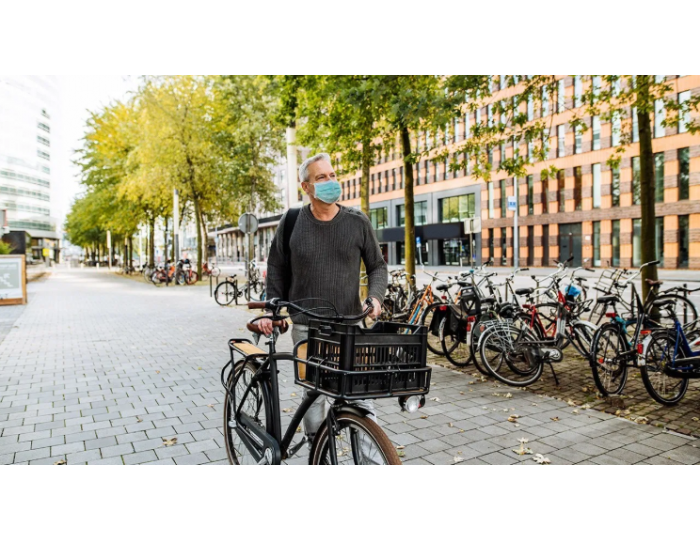How to Reduce Your COVID-19 Risk During Your Daily Work Commute

As businesses begin to reopen during the COVID-19 pandemic, they’re faced with the challenge of finding new ways to operate to keep their employees safe.
To assist businesses with this process, the U.S. Centers for Disease Control and Prevention (CDC) recently released a set of
These guidelines include recommendations for how employees can best stay safe while commuting to and from their jobs.
In particular, the CDC recommends traveling either alone or with someone you live with whenever possible.
The CDC’s latest guidance suggests that avoiding public transportation is your best bet when it comes to preventing the transmission of SARS-CoV-2.
Their guidance uses biking, walking, and driving your own personal vehicle as examples of suggested ways to commute.
In order to get more people to avoid public transportation, the CDC suggests that employers should offer their workers incentives.
According to Brian Labus, PhD, MPH, an assistant professor in the School of Public Health at the University of Nevada, Las Vegas, subways, buses, and carpools are places where people remain in close contact for an extended period of time.
“If you don’t live with those people,” said Labus, “it obviously increases the risk of exposure to coronavirus. By commuting individually or only sharing a car with people you live with, you minimize your exposure to others and reduce your risk of disease.”
The CDC’s recommendation to travel alone has been somewhat controversial.
It has raised concerns about how it will affect the environment.
Some experts fear that this change in policy will promote heavy traffic congestion. It could also reverse gains that have been made in reducing carbon emissions.
Some groups have also expressed concerns that lower-income individuals and people of color might be at a disadvantage when it comes to following this guidance.
In response to the criticism, the CDC did soften the original language somewhat, adding the words “if feasible” to the relevant passage.
“Unfortunately,” said Henry F. Raymond, DrPH, MPH, associate professor at Rutgers School of Public Health, “we can’t have it both ways. That is, we can’t minimize the potential for spread by encouraging mass transit.”
Regarding lower-income workers, Raymond noted that encouraging those who can afford to travel alone to do so will ultimately help those workers who are still forced to use public transportation.
Having fewer people using mass transit will give them a better chance of maintaining physical distance, he explained.
No matter how you get to work, the CDC says there are certain
- Wash your hands for at least 20 seconds with soap and water, or use hand sanitizer with at least 60 percent alcohol before and after your trip.
- Avoid touching your eyes, nose, or mouth with your hands.
- Cover your coughs and sneezes, throw used tissues in the trash, and wash your hands or use hand sanitizer after you cough or sneeze.
- Maintain at least 6 feet between yourself and other people who don’t live in your household.
- Wear a cloth face covering when you aren’t able to maintain physical distance between yourself and others. Wearing a mask on public transportation signals to others that you’re trying to keep the community safe in addition to yourself.
- Stay home when you’re sick or have been near someone who has COVID-19.
- Limit your travel if you’re older or have a disability or underlying health condition that puts you at greater risk.
- If you are at greater risk, bring a “transportation buddy” with you to help with any special needs that you have, such as carrying bags.
While traveling alone might be the best option in an ideal world, the CDC has altered their recommendations to reflect the fact that not everyone will be able to do so.
If you are using public transportation or ride sharing in order to get to your job, they recommend following the above general guidelines as well as certain specific guidelines related to your particular mode of transportation.
The
- When using public transit, stay up-to-date on any changes to services and procedures. This is especially important if you require any special assistance.
- Avoid touching things. Make use of touchless payment methods and no-touch trash cans and doors whenever possible. Wash your hands or use hand sanitizer as soon as possible after touching any frequently touched surfaces.
- Practice physical distancing. Travel during non-peak hours, if possible. Put at least 6 feet between yourself and other people. Follow any physical distancing markers like floor decals or signs that have been designated by your local transit authority.
- Practice good hand hygiene. Wash your hands and use hand sanitizer as needed.
- Improve ventilation. If you’re in your own vehicle or a passenger in a ride share or taxi, try to improve the ventilation by opening windows or setting the air ventilation or air conditioning on non-recirculation mode.
- Clean and disinfect surfaces. Use disinfecting wipes to clean any frequently touched surfaces prior to use.
